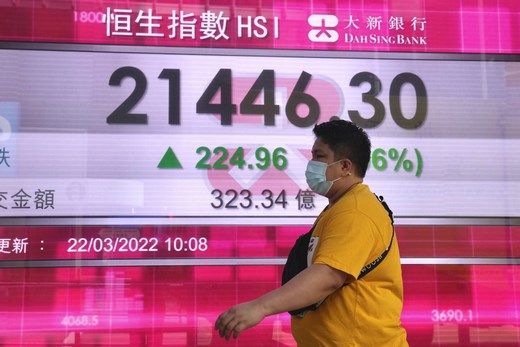
Morningstar Asia ex-Japan Sustainability Leaders Index – a collection of 50 large-cap stocks with the strongest environmental, social, and governance risk scores – is down 10.5% year to date as of April 25, 2022, which is 1.2% ahead Morningstar Asia ex-Japan Index. Over the five-year trailing period, sustainable leaders in Asia gained 9.6% on an annualized basis, outperforming the parent index’s 6.4% annualized return.
The retreat in the first four months of the year has brought investors opportunities to accumulate shares in the large-cap companies that are ESG-aware.
Morningstar uses the Sustainalytics ESG Risk Rating to better understand companies' sustainability practices. The Sustainalytics rating looks at a company's exposure to industry-specific, financially material ESG risks and factors in how well the company manages those risks. Each company is given a score and is classified as having a risk level that is Negligible, Low, Medium, High, or Severe compared with its industry peers. The Morningstar Asia ex-Japan Sustainability Leaders Index includes only companies with the strongest risk ratings--primarily companies with Negligible and Low ESG Risk Ratings.
We sorted the index to see which of the best-in-class sustainability stocks currently trade at the biggest discounts (all with Morningstar Ratings of 5 or 4 stars). The list only includes companies with Morningstar Economic Moat Ratings of wide or narrow, which our analysts believe have competitive advantages that could last at least 10 years.
Here are the eight most undervalued names in the index:
In the list, among the hardest-hit stocks this year have been ANTA Sports (02020), Hong Kong Exchanges and Clearing (00388), and Shenzhou International Group (02313), which tumbled 21.0%, 25.9%, and 28.8%, respectively. Narrow-moat Swire Properties (01972) was the only stock with negligible ESG risk that made the list, and is trading 36% below its fair value estimate.
Swire Properties Ltd 01972
“Swire Properties enjoys a narrow economic moat stemming from efficient scale. The company's flagship assets, Pacific Place, One Island East and the Taikoo Place Office Towers, represent the majority of the company's office and retail holdings in Hong Kong. Compared with other leading cities around the world, Hong Kong suffers from an undersupply of grade A office space, as well as a geographically limited central business district, or CBD. The undersupply is a result of the city's transition from a manufacturing economy to a service economy, as well as a historical government policy of limited land supplies. The undersupply and the small size of the CBD have led to a spillover effect and a broader decentralization trend, which proved beneficial to the company's flagship assets.”
-- Michael Wu, senior equity analyst
ANTA Sports Products Ltd 02020
“We assign Anta a narrow economic moat based on intangible assets for its demonstrated brand strength, as evidenced by average return on invested capital, or ROIC, of almost 60% from 2010 to 2020. For comparison, wide-moat Nike’s midcycle ROIC is around 30% while narrow-moat Adidas’ is around 16%. We still believe a strong brand intangible asset will allow Anta to achieve ROICs above the weighted average cost of capital, or WACC, for at least a decade. Over the past 10 years, the company raised its market share from around 5% to 15%, third behind Nike and Adidas’ respective 26% and 17% shares of the Chinese sportswear market. The company has a portfolio of more than a dozen brands, but two of these brands--Anta and Fila--generate almost all of the company’s revenue.”
-- Ivan Su, senior equity analyst
Taiwan Semiconductor Manufacturing Co Ltd 2330
“We believe TSMC’s wide moat stems from its cost advantage and intangible assets, which are realized from its leading position in process technology, or nodes.
Multiple technical barriers and high capital requirements form TSMC’s wide moat. Semiconductor manufacturing is inherently capital-intensive. While for every foundry each successive node requires exponentially more R&D and capital expenditures; customers are only willing to pay a premium to first movers.
One of TSMC’s intangible assets is its strong relationships with leaders in multiple subsectors, like Apple in mobile chips, Nvidia in graphic processors and Xilinx in reprogrammable chips. Combined with its leadership in process technology, TSMC can readily justify hefty investments in new process nodes by convincing customers to share detailed roadmaps, while smaller foundries have to build facilities first and wait for orders that TSMC cannot fill.”
-- Phelix Lee, equity analyst
Shenzhou International Group Holdings Ltd 02313
“We have assigned Shenzhou a narrow economic moat rating because of its intangible assets. We believe the company’s entrenched relationships with its customers also supports the firm’s intangible asset moat source. Being one of the largest suppliers for Nike, Adidas, Puma, and Uniqlo, Shenzhou supplies about 17%, 20%, 40%, and 15% respectively for the brands mentioned above’ apparel lines. These are large percentages for a single supplier in the world of retail because large brands such as Nike always want to maintain diversified manufacturer bases. Shenzhou has not lost any one of its key customers in the past 10 years, but continues to deepen its relationships by improving production lead time, diversifying factory locations, implementing automation processes, and establishing clear environmental, social, and governance, or ESG, standards.
One of the greatest supply chain challenges facing apparel retailers is sourcing products from reliable manufacturers efficiently. Shenzhou’s entrenchment in the supply chain is a result of apparel retailers’ rising demand for shorter turnaround times.”
-- Ivan Su, senior equity analyst
NetEase Inc Ordinary Shares 09999
“We assign NetEase a narrow moat rating based on its intangible assets from its widely recognized intellectual property in the form of compelling game franchises. NetEase is the second-largest game publisher in China, with about 20% of the revenue market share in 2020. Over the past decade, China's game industry has seen a shift from PC to mobile, and NetEase has capitalized on the transition and turned itself into a publisher with multiple franchises across mobile and PC. The firm has published a total of more than 30 PC games and 100 mobile games. Some of the most well-known franchises include Fantasy Westward Journey, Westward Journey Online, Onmyoji, and the recently published Naraka Bladepoint.”
-- Ivan Su, senior equity analyst
Hong Kong Exchanges and Clearing Ltd 00388
“HKEx’s competitive advantage stems from cost advantage, network effect, and intangible assets. These competitive strengths allow the firm to enjoy higher profitability and return on invested capital versus its global peers. HKEx's cost advantage stems from its vertically integrated financial exchange. The exchange provides trading, clearing, and settlement services on equities, derivatives, and debt securities in Hong Kong. This is supported by economies of scale and high operating leverage in the business model. As a sole operator of the above services, all market participants trading these securities must do so with HKEx, creating a network effect. HKEx's operation is supported by stable regulatory and currency regimes in Hong Kong.”
-- Michael Wu, senior equity analyst
Link Real Estate Investment Trust 00823
“We believe Link REIT's efficient scale allows it to benefit from a narrow economic moat. The company's assets were originally developed 10 to 30 years ago to serve nearby public housing estates. They are generally located in heavily trafficked and built-up areas with large residential catchments, including those living in private housing estates. Frequently, the company's assets represent the only, or the majority of, district-sized shopping centers in the surrounding areas. The high cost of land in these built-up areas has generally deterred the development of stand-alone shopping centers, leaving private estate residents served by neighborhood centers nearby or regional centers further afield. The market position of Link's assets supports efficient scale as an economic moat source.”
-- Michael Wu, senior equity analyst; Kathy Chan, associate equity analyst
CapitaLand Integrated Commercial Trust C38U
“We believe CapitaLand Integrated Commercial Trust has a narrow economic moat, derived from efficient scale from its Singapore retail and office assets. CICT's retail and office assets in Singapore effectively and efficiently serves its own submarkets and its business is protected from competition by factors such as mature demand, excess capacity, significant barriers to entry and historical precedent. With respect to the competition for tenants, we think that landlords with multiple properties within a city, such as CICT, have a slight competitive advantage over landlords with single assets.”
-- Xavier Lee, equity analyst












.png)







.jpg)





